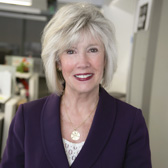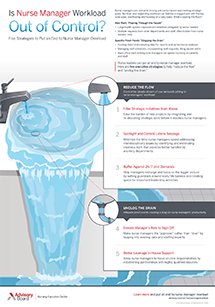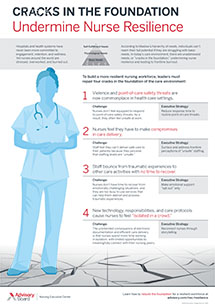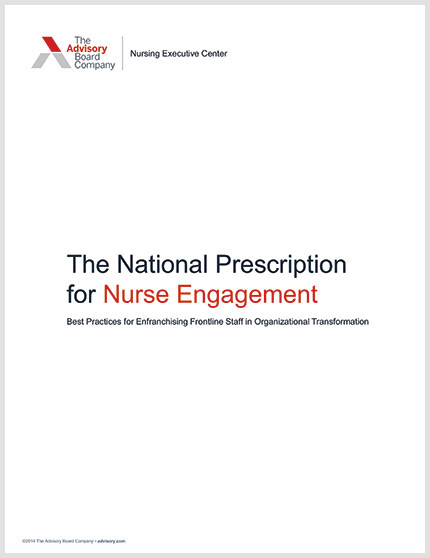Auto logout in seconds.
Continue LogoutRead Advisory Board's take: 3 best practices to create leadership pathways for nurses
Nurse leaders play a vital role in hospital care, but there aren't enough nurses in the leadership pipeline, according to a NEJM Catalyst report. From biased colleagues to a lack of clear pathways, here's what's keeping nurses out of non-CNO leadership roles—and how to get them there.
Not many nurses in leadership
For the report, researchers in August surveyed 682 clinical leaders and health care executives.
The researchers found that, despite nurses' bedside experience and perspective, nurses typically hold a minority of leadership positions. According to the survey, 63% of respondents estimated that nurses hold fewer than 25% of leadership roles. Only 18% of respondents estimated nurses hold at least 50% of the leadership roles at their organization.
3 reasons there aren't more nurse leaders
The survey identified several factors that might explain why nurse leaders are relatively small in number.
One explanation might be that nurses simply aren't interested. In the survey, 58% of respondents estimated that fewer than 25% of nurses are interested in leadership roles.
What's the source of the disinterest in leadership?
1. A love of bedside nursing
Some suggest it's a love of bedside nursing that keeps nurses away from leadership roles.
Catalyst report co-author Stephen Swensen, Professor Emeritus at Mayo Clinic College of Medicine and a senior fellow, at the Institute for Healthcare Improvement, said, "You've got these nurses who spend these years training, love what they do, and don't want to move beyond it."
2. Biased colleagues
But some responses to the Catalyst survey suggest it's not love of the bedside keeping nurses away from leadership roles—bias against nurses might discourage them from seeking leadership roles.
According to the Catalyst report, nurses face an inherent gender bias and might also be pigeonholed by the perception that nurses are "doers" rather than strategists.
And nurse leaders might not get the same respect as their physician leader peers. Non-nurses were less likely than nurses to say nurse leaders and physician leaders should be considered equal regarding care delivery. According to the survey, 87% of nurses said nurse leaders and physician leader should be considered equal regarding care delivery. But that figured dropped 20 points among respondents who weren't nurses.
Here are some of the things commenters who didn't think nurse leaders should be considered physician leaders' equals had to say:
A clinician at a midsized for-profit physician organization in the West, said there are "[d]ifferent expectations regarding productivity etc." The commenter added that's "not to say [nurses] are not valuable and bring great ideas, but [that] there is a qualitative difference" between nurses and physicians.
Another commenter, director at a large for-profit teaching hospital in the South, said, "Some [nurses] should [be leaders] just like some MDs should not. But in general the MDs are the subject matter experts in care delivery."
3. It's unclear how to get there
Another, perhaps less controversial, explanation for the relatively small number of nurse leaders might be lack of clarity about a path to leadership, according to the Catalyst report. Nurse respondents in the survey were less likely to say they saw a pathway to leadership at their organization that non-nurse respondents. Among nurse respondents, 48% saw a path to leadership, compared with 68% of non-nurse respondents (Swenson/Robel, NEJM Catalyst, 12/6/18; Rappleye, Becker's Hospital Review, 12/10/18).
Advisory Board's take



Carol Boston-Fleischhauer, JD, MS, BSN, Chief Nursing Officer and Managing Director, Katherine Virkstis, Managing Director, and Marisa Deline, Practice Manager, Nursing Executive Center
In our years speaking with nurses and nurse leaders around the country, we've heard about many of the same challenges and sentiments as the ones expressed this survey. In particular:
“This may be changing with the millennial generation”
- A love of bedside nursing. Certainly, nurses often love what they do and may want to stay in roles that allow them to deliver direct care at the bedside. But this may be changing with the millennial generation. Our research has found, as a respondent in the survey also notes, that millennials are often highly ambitious and eager to explore new opportunities within nursing. This could galvanize more nurses to pursue broader leadership positions in the future.
- Biased colleagues. We've heard many of the same biased opinions about physician leaders versus nurse leaders. Indeed, while many organizations are comfortable elevating physicians to leadership positions without additional training, the same is not often true for nurses.
- Unclear career pathways. Many nurse leaders struggle simply moving laterally within the practice environment, let alone upwards. In fact, we don't know of one health care system that encourages nurses to have leadership internships or experiences in the C-suite other than with the CNO.
We would also add two additional barriers that we've seen hold back would-be leaders:
- Nurse managers are often overtaxed. Nurse managers typically have a lot on their plates. So much so that many of them struggle against burnout. These feelings of stress and burnout can influence their ability to be promoted as well as their desire to do so. In addition, when bedside nurses see the stress and pressure their managers are under, it often prevents them from pursuing those management positions themselves.
- Academia may be playing a part. We suspect that academia could be contributing to this trend, by not actively encouraging nursing students to even consider broader leadership opportunities within the healthcare organization outside of the nursing enterprise.
All of these barriers certainly add up to a less-than-ideal environment for nurse leadership. So what can organizations do to change this status quo and elevate more nurses to leadership positions? We'd suggest the following:
- Create forums for nurses to interact with senior leaders.When we interviewed leading organizations for our research about engaging millennial nurses, we found several exemplary programs that connected young nurses with hospital leadership. For instance, Miami Valley Hospital (MVH) in Dayton, Ohio created a practice for "speed mentoring" where junior nursing staff at the organization met with senior leaders for seven-minute sessions to discuss career pathing and professional experiences. In a survey following their third event, 95.3% of attendees reported the program helped them understand what it takes to succeed at MVH.
To see how your own organization can adopt this practice, view our first-year nurse retention toolkit, which includes everything you'll need like: a preparation checklist, tips for the session, presentation scripting, customizable slides, discussion prompts, and a follow-up survey.
- Rebuild the clinical ladder to offer stronger professional development opportunities. The typical, hierarchical nurse clinical ladder can sometimes restrict nurses' leadership ambitions. That's why Gundersen Health System in LaCrosse, Wisconsin, eliminated it entirely in 2012 and replaced it with a different-in-kind model aimed at encouraging professional development. This new model allowed staff to mix and match leadership opportunities—and thus break out of the traditional nursing path. A 2013 survey found that 64.3% of RNs agreed that the leadership and training opportunities they received in the model helped them improve, and 59.8% reported interest in promotion opportunities (over 6% more than the national average).
To learn more about Gundersen's model, including the leadership opportunities they identified, view page 94 of our National Prescription for Nurse Engagement.
- Perform a nurse manager time audit. Many nurse managers report feeling overwhelmed and that their day-to-day is absorbed by time-consuming tasks such as scheduling, managing patient flow, and budgeting—rather than the leadership activities executives want them to prioritize. To help understand how nurse managers are truly spending their time—and help them prioritize leadership—we suggest completing a time audit. For a customizable audit tool, as well as a comprehensive workbook to lead you through the tool, download our Nurse Manager Time Audit toolkit.
At the end of the day, executive succession plans for healthcare organizations and systems will greatly benefit from recognizing both the broad and holistic preparation of the professional nurse, and nurses' unique potential to serve in healthcare leadership roles.
Get the national prescription for nurse engagement
It's more important than ever for frontline nurses to be engaged in their work, committed to their organization's mission, and capable of delivering high-quality care in a complex and constantly changing environment.
This report identifies the unique challenges of engaging nurses and equips nurse leaders with five strategies for building a highly engaged workforce.
Don't miss out on the latest Advisory Board insights
Create your free account to access 1 resource, including the latest research and webinars.
Want access without creating an account?
You have 1 free members-only resource remaining this month.
1 free members-only resources remaining
1 free members-only resources remaining
You've reached your limit of free insights
Become a member to access all of Advisory Board's resources, events, and experts
Never miss out on the latest innovative health care content tailored to you.
Benefits include:
You've reached your limit of free insights
Become a member to access all of Advisory Board's resources, events, and experts
Never miss out on the latest innovative health care content tailored to you.
Benefits include:
This content is available through your Curated Research partnership with Advisory Board. Click on ‘view this resource’ to read the full piece
Email ask@advisory.com to learn more
Click on ‘Become a Member’ to learn about the benefits of a Full-Access partnership with Advisory Board
Never miss out on the latest innovative health care content tailored to you.
Benefits Include:
This is for members only. Learn more.
Click on ‘Become a Member’ to learn about the benefits of a Full-Access partnership with Advisory Board
Never miss out on the latest innovative health care content tailored to you.



